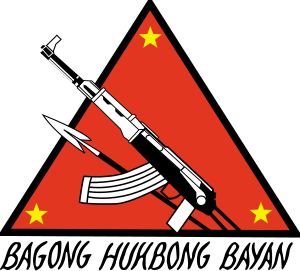History
The Communist Party of the Philippines (CPP) was reestablished on December 26, 1968, coinciding with the 75th birthday of Mao Zedong, the Chinese communist leader of the People's Republic of China (PRC).
Amado Guerrero, then a central committee member of Partido Komunista ng Pilipinas or PKP-1930, lead the reestablishment of the party. Jose Maria Sison, allegedly the man behind the nom de guerre Amado Guerrero, confirmed its birth at Barangay Dulacac in the tri-boundary of Alaminos, Bani and Mabini in the province of Pangasinan. This is where the CPP's "Congress of Reestablishment" was held on December 26, 1968, at a hut near the house of the Navarettes, the parents-in-law of Arthur Garcia, one of the CPP founders.[11]
Jose Maria Sison is the central figure behind the CPP and its formation. According to Party documents, in the 1960s, a massive leftist unrest called First Quarter Storm occurred in the country to protest against the government policies, graft and corruption and decline of the economy during the presidency of Ferdinand Marcos. The unrest was also inspired by the Great Proletarian Cultural Revolution, the Vietnam War and other revolutionary struggles abroad against United States imperialist aggression.[12] One of the leaders of this leftist movement was Jose Maria Sison, a founder of Kabataang Makabayan. He was soon recruited to be a member of Partido Komunista ng Pilipinas (PKP-1930). During that time the new PKP members, independently from the incumbent PKP members, were conducting clandestine theoretical and political education on Marxism–Leninism, with special attention dedicated to workers, peasants and youth. This would eventually lead to a significant split between the PKP members. The new members advocated to resume what they regarded as the unfinished armed revolution against foreign and feudal domination, referring to the legacy and de facto continuation of the Philippine–American War of 1899, combat
subjectivism and opportunism in the history of the old merger party and fight modern revisionism then being promoted by the Soviet Union.[citation needed] This ideology was the basis for the split from the PKP-1930, the (re)creation of the CPP, and the subsequent "Congress of Reestablishment."
Reestablishment Congress[edit]
Irreconcilable differences occurred between the new party members with the leadership of the PKP under Jose Lava. Sison, was tasked by PKP to conduct a review of the party history of the old merger party.
However, on his report, leaders of the PKP headed by Jesus Lava disagreed with Sison's findings that criticized the major errors of the PKP which caused the almost total destruction of the revolutionary movement in the 1950s. A sharp division and struggle developed between them in ideological and political issues, Sison and his group led the reestablishment of the party after he and his colleagues bolted out from the PKP. Jesus Lava, the General Secretary of the PKP, was labelled a "counterrevolutionary revisionist", and the new leaders also attacked what they called "the gangster clique" of Pedro Taruc-Sumulong in the old people's army of the Hukbong Mapagpalaya ng Bayan (HMB), remnant of the Hukbalahap in Central Luzon.[citation needed]
The Party issued the document of rectification, "Rectify Errors and Rebuild the Party," and promulgated the Programme for a People's Democratic Revolution and the new Party Constitution in its Congress of Reestablishment. The two communist parties deviation was clear ideologically when the Lava's PKP was supporting the Communist Party of the Soviet Union whom Sison's group considered revisionist while the latter supported the line of the Chinese Communist Party.[13]
The reestablishment was centered on a comprehensive and thoroughgoing criticism and repudiation of modern revisionism and of the leadership of the Lavas in Manila as well as the Taruc-Sumulong grouping which had usurped authority over remnants of the HMB.[14]
The party congress was attended by 12 members, namely Jose Maria Sison, Monico Atienza, Rey Casipe, Leoncio Co, Manuel Collantes, Arthur Garcia, Herminihildo Garcia, Ruben Guevara, Art Pangilinan, Nilo Tayag, Fernando Tayag at Ibarra Tubianosa. Jose Luneta was counted as the 13th member. He was elected in the Central Committee in absentia, since he was still in China.


